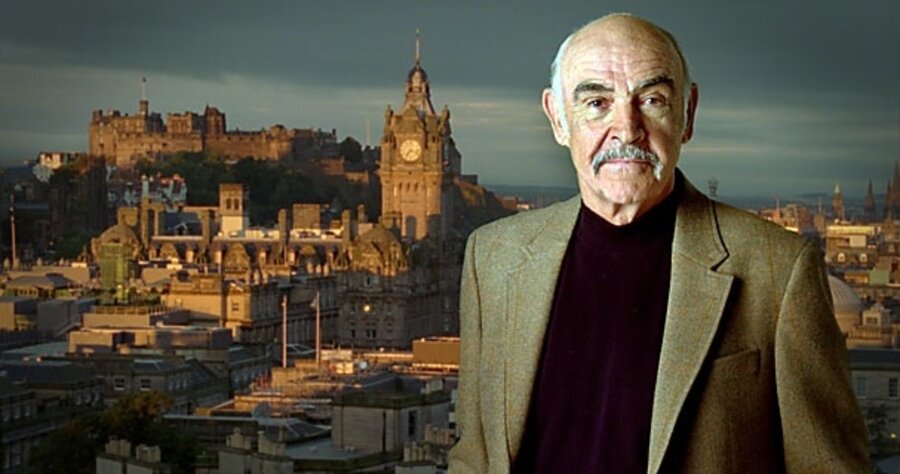Scotland turns to 18th-century poet for economic stimulus
Loading...
Can an 18th-century poet help save Scotland's faltering economy?
Keen to find ways of boosting the economy as it heads into increasingly dark times, the Scottish government recently unveiled an initiative that banks on famed poet Robert Burns to lure tourists to visit and invite expatriate Scots to come home.
This year is the 250th anniversary of the poet’s birth and the start of a year-long celebration across Scotland, much of it centered here in Dumfries, where Burns spent a large portion of his life.
Standing by the original manuscript of Burns's "Auld Lang Syne" in Edinburgh's National Library of Scotland, the country's first minister, Alex Salmond, used his New Year message to describe the "Homecoming Scotland," initiative:
"As we enter a new year, a wonderful opportunity presents itself to turn a threatened tourism downturn into a visitor boom."
Economic stimulus or political diversion?
Political opponents, while supporting the idea of a homecoming, see the first minister's enthusiasm as little more than an attempt to deflect attention from the country's economic problems and promote his own agenda of Scottish independence. Mr. Salmond wants to hold a referendum on a split with the rest of the United Kingdom in 2010.
Since 1999, the country has had its own parliament, but remains within the UK, alongside England, Wales, and Northern Ireland. It has powers over education and healthcare, but others, like defense and foreign affairs remain with the Westminster government in London. Salmond wants Scotland to go one step further and become completely independent.
Whatever his intentions, Scotland is going to need all the help it can get this year. The Scottish Council for Development and Industry predicts 2009 will be an "incredibly difficult year" for Scotland's economy, with negative growth expected for the first time in almost three decades.
Tourism totals $5.5 billion a year
Tourism, still very strong here, is viewed as part of the solution. It's one of Scotland's biggest industries, drawing $5.5 billion from tourists and providing about 200,000 jobs – roughly one out of every 12 jobs.
Few, if any, places have stronger links to Burns than Dumfries, a picturesque town of about 30,000 people near the border with England. It was once said that Dumfries was "The grandest city in the world, for thou hast Burns's grave." With this in mind, many here are banking on "Homecoming Scotland" being translated into a sharp increase in visitors this year.
Among the town's other Burns's sites is the Globe Inn, Burns's favorite pub, which retains the same wood panels and beams, and even the "Burns's chair," where the poet once held court. Pub owner Marion McKerrow welcomes the homecoming plans.
"It's time to highlight what Robert Burns is about and the attraction he is all over the world," she says.
A poor boy named 'Rabbie'
Robert Burns – better known as Rabbie – was born in Ayrshire on Scotland's west coast in 1759. One of seven children, he grew up in poverty and hardship, but was well-educated by his father, reading the Bible and Shakespeare from an early age. He had some schooling and began writing verses while also working as a farm laborer and plowman.
He went on to write scores of poems and songs in the Scots dialect and became known as "The Ploughman Poet." His works include "O my Luve's Like a Red, Red Rose," "Address To a Haggis," and "Scots Wha Hae," once considered Scotland's unofficial national anthem. He enjoyed tremendous success and travelled all over Scotland, settling in Dumfries before his death at 37.
This weekend is key test
The first real test of the year's initiative will come this weekend as the homecoming year is launched with events in Edinburgh, Glasgow, Dumfries, and Ayrshire. Jan. 25th each year is known as Burns Night, when people gather for traditional suppers of haggis, neaps and tatties (turnips and potatoes), and to hear readings from Burns's works. In Dumfries, four lantern processions will make their way through the town, converging for a fire show and a display of traditional celtic music ahead of one of the country's biggest Burns suppers.
Skeptics of the initiative, including Elaine Murray, Dumfries' Labour Member of the Scottish Parliament, asks what impression visitors will get of town's like Dumfries if the Scottish Government doesn't do more to rescue the economy.
"What they're going to see is a pretty empty looking High Street with a lot of closed- down shops," she says. "We need to know how the Scottish Government intends to promote town center regeneration.... All we've got here is warm words and nothing very substantial at all."
Mr. Salmond, however, spoke in his New Year message of a "spirit of optimism abroad that will pull us through the hard times." He ended his address by quoting from Burns's poem "For A' That and A' That:"
"For a' that, an a' that,
It's comin yet for a' that,
That man to man the warld o'er,
Shall brithers (brothers) be for a' that."
Many in Dumfries hope he's right.





